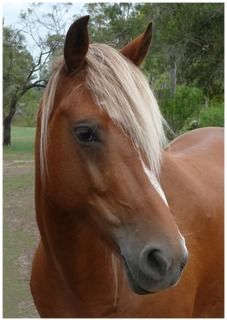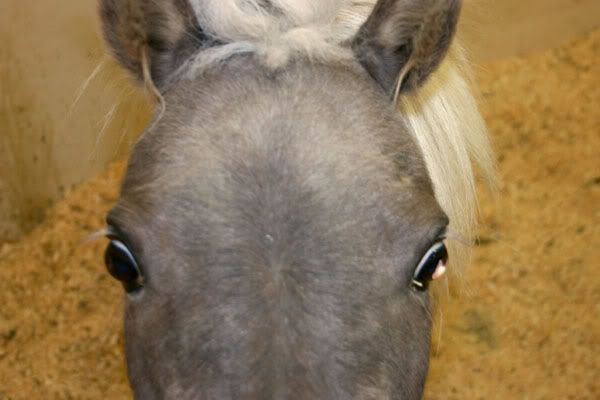For people, inheriting the family silver can be a mixed blessing, depending on your feelings regarding elderly cutlery or dinnerware. Horses have it easier: they don't have any cutlery at all, and inheriting the family silver often means they have unusual - and absolutely stunning - coat colours.
 |
| Yes, this horse is real. Can I have one please?? This silver dapple horse is SC Code Of Honor, a Rocky Mountain Horse stallion (pic linked through from here). |
When a horse or pony inherits either one or two copies of a rare version of the PMEL17 gene (melanocyte 17 precursor gene) known as
silver, it alters the production of black pigment in their coat in an analogous manner to the way
cream alters the production of red pigment. The mane and tail of the horse become a cream or silver colour, while the short hair on the body is only slightly affected. Simple concept, amazing result.
As I've said in all these horse genetics articles, the important things to remember when discussing genes are:
- Your horse has two copies of each gene*, one inherited from either parent;
- There are many different versions of each gene in the horse
population, some of which can produce identical or nearly identical
appearance and biological function, while other versions can produce a
different coat colour or cause disease; and
- Each physical characteristic of your horse, including coat colour,
results from the combined effects of the two copies of each gene, AND
the interactions between a large number of different genes.
 |
| I did not know that bay silver could be soooo good-looking. Meet Kelsie Park Mirinda - what a glamour! |
In this case, it's important to remember that the versions of the PMEL17 gene known as
silver interact with the
basic coat colour genes. When the basic coat colour is black and a silver gene is present, the horse or pony will be black silver (also called silver dapple): a cream or white mane and tail with a dark grey or dark chocolately brown body that generally has strong dappling patterns. When the basic coat colour is bay/brown, the horse or pony will be bay silver: the rich red body of a bay with a creamy mane and tale, as you can see on Kelsie Park Mirinda above.
So far, so good, or at least so gorgeous.
The tricky bit is that when silver interacts with a basic coat colour of chestnut, you get chestnut. "What?", I hear you say. But yes, it's true: with no black pigment to act on, there is no change to the colour. Chestnut plus silver equals chestnut. The family silver hasn't exactly been stolen though, just hidden. A chestnut with the silver gene can pass it on to their own foals.
So is there any difference in appearance between a horse or pony with one copy of the silver gene and one with two copies? I can't find anything definitive, but image searches suggest that there is no obvious difference. If you want to know, genetic testing would be the quickest way to find out.
 |
| Eye abnormalities and the silver coat colour. Follow this link to see the full description of the eye abnormalites illustrated in part A and part B. |
The beautiful silver coat colour comes with a flip-side: Multiple Congenital
Ocular Anomalies (MCOA) syndrome. A
scientific paper published in 2013 by a team of researchers in Sweden concluded that it's not a coincidence that silver horses are often diagnosed with MCOA, because the same mutation that causes that beautiful silver coat also causes these malformations of the eyes. (Thank-you for your good work Lisa S. Andersson,
Maria Wilbe,
Agnese Viluma,
Gus Cothran,
Björn Ekesten,
Susan Ewart, and Gabriella Lindgren.)
For horses that inherited one copy of the silver gene, the most common eye abnormality is cysts within the eye. These generally don't cause noticeable vision problems, and there is no indication of that the condition is painful. The cysts can run along or between various structures in the eye (some can be seen on the right side of the eye in Part A of the illustration above). In rare instances, these horses can have retinal detachment or other retinal abnormalities that appear result from continuation of cysts into the retina. This is very likely to affect the horse's vision. If you think this may be the case for your silver horse (remembering horses with the silver gene can be chestnut too), your vet should be able to confirm it for you. The management guidelines for appaloosa horses with night blindness have some good ideas for dealing with horses with poor vision in low light.
 |
Uh-oh... look
at this miniature mare's left eye. This bulging eye is an obvious
outward indication of extensive eye abnormalities caused two copies of
the silver gene. Picture linked from here (warning, image is part of a series than includes dissection of the eye).
|
Horses that have inherited two copies of the silver gene (i.e. one from each parent) generally have much more severe forms of MCOA, although their vision can still be OK. The list of eye abnormalities that can occur for these horses is extensive, including cataracts, misshapen and/or non-responsive irises, misshapen and enlarged cornea (see the bulging eye of the mare pictured above), as well as cysts that are generally more extensive and numerous than for horses with a single copy of the gene. However no single horse is likely to have all these abnormalities at once, and their effect on the horse's vision can be widely variable.
All of these eye abnormalities develop before birth. There is also a lot of variation between horses (and between ponies) with regards to how many abnormalities there are, and how they affect the horse's vision. This can give people wanting to own a silver horse or pony (I'd include myself in this category!) some confidence: if you are happy with the horse's performance and vision in a pre-purchase test or examination, the nature of this syndrome means that it is unlikely to progress.
 |
| A sweet silver dapple foal with her gorgeous silver dapple mother (pic linked through from here). |
If you are a breeder of silver horses, please consider the severity of eye problems that can come with two copies of the silver gene. I would recommend
against breeding a silver horse or pony to another silver - although the risk isn't huge, there is a chance of producing a foal with such poor vision that it will cause heartache and expense wherever it goes.
Do you want to know if your horse has one or two copies of the silver gene? At
Practical Horse Genetics we are currently working to add this test to our repertoire and it should be available shortly.
* Except for genes on the X and Y chromosomes in male horses, where there may be only one copy.




No comments:
Post a Comment